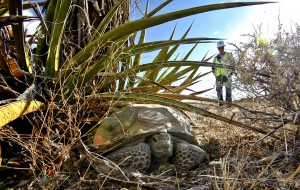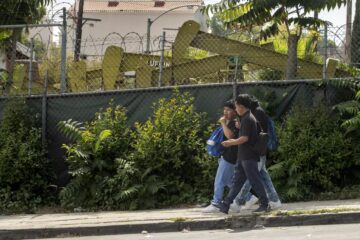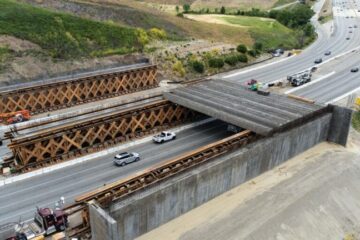Saving desert tortoises is a costly hurdle for solar projects
BrightSource Energy has spent $56 million so far to protect the threatened creatures, but calamities have befallen the effort.
Source of this article: The Los Angeles Times, March 4, 2012

IVANPAH VALLEY, CALIFORNIA, Bureau Of Land Management California Desert District Biologist Larry LaPre keeps his distance from an older male desert tortoise being monitored by biologists with a locator device. The tortoise hunkers down in the safety of his temporary housing under some desert foliage outside the gates of the BrightSource Ivanpah Solar construction site in area deemed safe and away from construction.
Stubborn does not come close to describing the desert tortoise, a species that did its evolving more than 220 million years ago and has since remained resolutely prehistoric.
Its slowpoke take on biological adaptation has exposed modern vulnerabilities. The persnickety reptile is today beset by respiratory infections and prone to disease. Its only defenses are the shell on its back and the scent of its unspeakably foul urine.
How this creature the size of a shoe box became the single biggest obstacle to industrial-scale solar development in the Mojave Desert is turning into a true story of the survival of the fittest.
PHOTOS: Protecting the desert tortoise
At the $2.2-billion BrightSource Energy solar farm in the Ivanpah Valley, the tortoise brought construction to a standstill for three months when excavation work found far more animals than biologists expected.
BrightSource has spent $56 million so far to protect and relocate the tortoises, but even at that price, the work has met with unforeseen calamity: Animals crushed under vehicle tires, army ants attacking hatchlings in a makeshift nursery and one small tortoise carried off to an eagle nest, its embedded microchip pinging faintly as it receded.
History has shown the tortoise to be a stubborn survivor, withstanding upheavals that caused the grand dinosaur extinction and ice ages that wiped out most living creatures. But unless current recovery efforts begin to gain traction, this threatened species could become collateral damage in the war against fossil fuels.
GRAPHIC: Impact of solar projects on desert tortoises
Costly conservation efforts by state and federal agencies and solar companies have created a mishmash of strategies that one scientist says amounts to a “grand science experiment,” said Jeff Lovich, who studies the impact of renewable energy projects on desert tortoises for the U.S. Geological Survey.
“One could argue that they are nature’s greatest success story,” Lovich said. “Yet over half the world’s turtles are in dire need of help. The common denominator is humans. They may not survive us.”
An ideal site
BrightSource’s project at Ivanpah is the first large-scale solar plant to enter the desert tortoise regulatory maze. Its experience is a case study for how the booming solar industry must deal with the reptile.
Long before construction began, BrightSource was warned that the site was thick with tortoises, more so than any of the other dozen solar farms planned for that part of the Mojave.
But BrightSource wanted the site because it is ideal for generating solar power. So the company negotiated with state and federal agencies to hash out meticulously detailed protocols for collecting and relocating tortoises, also agreeing to monitor them for five years after they were moved.
The company made its first concession to the tortoise during planning, giving up about 10% of its expected power output in a redesign that reduced the project footprint by 12% and the number of 460-foot-tall “power towers” from seven to three.
BrightSource also agreed to install 50 miles of intricate fencing, at a cost of up to $50,000 per mile, designed to prevent relocated tortoises from climbing or burrowing back into harm’s way.
The first survey of tortoises at the site found just 16. Based on biological calculations, the U.S. Fish and Wildlife Service issued BrightSource a permit to move a maximum of 38 adults, and allowed a total of three accidental deaths per year during three years of construction. Any more in either category and the entire project would be shut down.
The limit put the company under enormous pressure, as more and more tortoises began cropping up and BrightSource’s project came closer to the federal thresholds.
The pressure boiled over after company biologists discovered an adult female tortoise with its carapace crushed in October 2010, during a media tour of the site. Biologists concluded that a vehicle struck the animal and ordered it euthanized.
A flurry of emails ensued. Steve DeYoung, then a BrightSource vice president, wrote to a federal biologist: “How in God’s name could anyone blame us? It is completely unconscionable that we would be blamed for this. I simply cannot sit back and watch this happen.”
Ultimately, the death was not attributed to the project. But other mishaps occurred, many of them documented in 36 boxes of project files stored at the Bureau of Land Management office in Needles.
The reports read like medical charts: a juvenile had his right forelimb gnawed by rodent, a tortoise died of heat distress after being caught in the black plastic erosion fencing, hatchlings were set upon by army ants, which killed four babies still in their eggs and injured four others.
The project’s bottom line took on an inevitable arc: as tortoise numbers rose, costs went up.
BrightSource, which was paying to have as many as 100 biologists to be on the site at one time, began seeing red. The company warned that tortoise mitigation was jeopardizing Ivanpah’s viability. In an email to a BLM official, DeYoung complained that tortoises were at that point costing the company as much as $40 million. “This truly could kill the project,” he wrote.
BrightSource lawyer Jeffrey D. Harris wrote to the California Energy Commission to suggest that if the Ivanpah crashed because of tortoises, the state’s renewable energy goals would meet the same fate.
By February 2011, all parties realized that the site contained more tortoises than allowed under the permit. Two months later, state and federal agencies ordered construction suspended until a new biological assessment could be completed.
When BLM officials inquired about the slow pace of the work, Amy Fesnock, BLM’s lead biologist for endangered species, sent an email up the BLM food chain stating that many requests for data were apparently being ignored by BrightSource.
Referring to BrightSource Energy by the shorthand BSE, Fesnock wrote, “The ‘crisis’ that this project is in is purely of BSE’s making. If we continue to reward their bad behavior — contorting ourselves to solve the problems that they keep creating, we have no hope of them not creating a new problem for us to solve.”
Fesnock told The Times recently that her issues with former BrightSource project managers had been resolved and called the work of the company’s biologists “phenomenal.”
At Ivanpah today, 166 adult and juvenile tortoises have been collected and moved to a nine-acre holding facility. The objective is to release them into the “wild,” on the other side of the fence from the solar facility.
Tools of survival
Desert tortoises were not always so scarce. They thrived in a harsh environment with the few tools nature provided.
To ward off predators, they spritz pungent bladder contents around their burrows, where they spend as much as 95% of their lives. When tortoises hear thunder — signaling a desert storm — they come topside and lower the side of their shells like bulldozer blades to gouge out water catchments. They can increase their body mass by 30% to 40% by guzzling water in this way, a quenching that can sustain them for more than two years without another drop.
The animals were once so abundant that Southern Californians used to bring the small ones home from desert trips as souvenirs, and the animals lived quiet lives in suburban backyards.
Once the tortoise was added to the endangered species list in 1990, however, a reverse diaspora occurred. Panicked moms and dads streaked back to the Mojave to release the now-protected tortoise. The story does not end there, nor does it end well. The former captives brought with them disease that spread and killed tortoises across the Mojave.
About the same time, desert recreation increasingly began to include off-road vehicles, which crushed either the animals or their burrows. The dust kicked up by the machines exacerbated the animal’s propensity for upper respiratory infections.
As Southern California’s exurbs marched east, trash dumps came with them, bringing ravens — one of the tortoise’s most effective predators. Finally, roadways crossing the desert to connect population centers and provide for recreation along the Colorado River laid down an asphalt moat that, as much as anything, defined the new de facto tortoise habitat.
BrightSource’s difficulties with the tortoise raise hackles among people who believe government protections afforded to animals are too extreme. Even before solar power entered the picture, state and federal agencies had spent nearly $200 million since 1990 toward the care and feeding of the desert tortoise.
California requires developers to provide two acres of suitable tortoise habitat for every acre of habitat taken. But the scale of the solar development coming to Western deserts is so vast that it renders the formula unworkable. Not enough alternative land exists.
Instead, solar developers may now pay to close off-road vehicle routes, rehabilitate degraded habitat on federal land, fund public education programs and erect miles of special fencing to keep the tortoises off highways and out of solar energy sites.
Homing instinct
Tortoise relocation is a formidable issue. Moved animals nearly always attempt to plod home, piloted by an uncanny sense of direction.
“If I pick you up and drop you off in Kansas, wouldn’t you try to come back to California?” Fesnock asked. Tortoises live long and have good memories, she said. “They know when they are not at home. They know where the water is. They know where the food is.”
For now, wildlife officials are still unsure if they will release animals this spring because a drought is expected this summer.
To date, just one desert tortoise has been relocated at Ivanpah.
Last October, a tagged female, BS-71, had been in a holding pen for four months and wasn’t adapting. She endlessly paced her enclosure. Over and over the animal attempted to climb the wire mesh, gaining some height, then usually ending up flipping on her back.
Unable to bear the sight of the tortoise’s apparent distress any longer, BrightSource lead biologist Mercy Vaughn sought permission to release the female to the wild. The request has since been dubbed the “Mercy Rule.”
After gaining approval from the U.S. Fish and Wildlife Service, filling out paperwork, providing medical testing — a tortoise under stress is more susceptible to disease — Vaughn was finally cleared to free the homesick tortoise.
The animal was placed in a purple plastic bin and carried deep into the desert. While a dozen people looked on, some filming the event, the tortoise was gently placed at the entrance of a burrow. She hesitated for a moment, then shuffled down into the gloom.
Moments later BS-71 reemerged, blinked and began munching grass.
ABOUT THIS SERIES: This is the fourth in a series of occasional stories chronicling the wide-ranging effects on the West of the emerging solar-energy industry.


